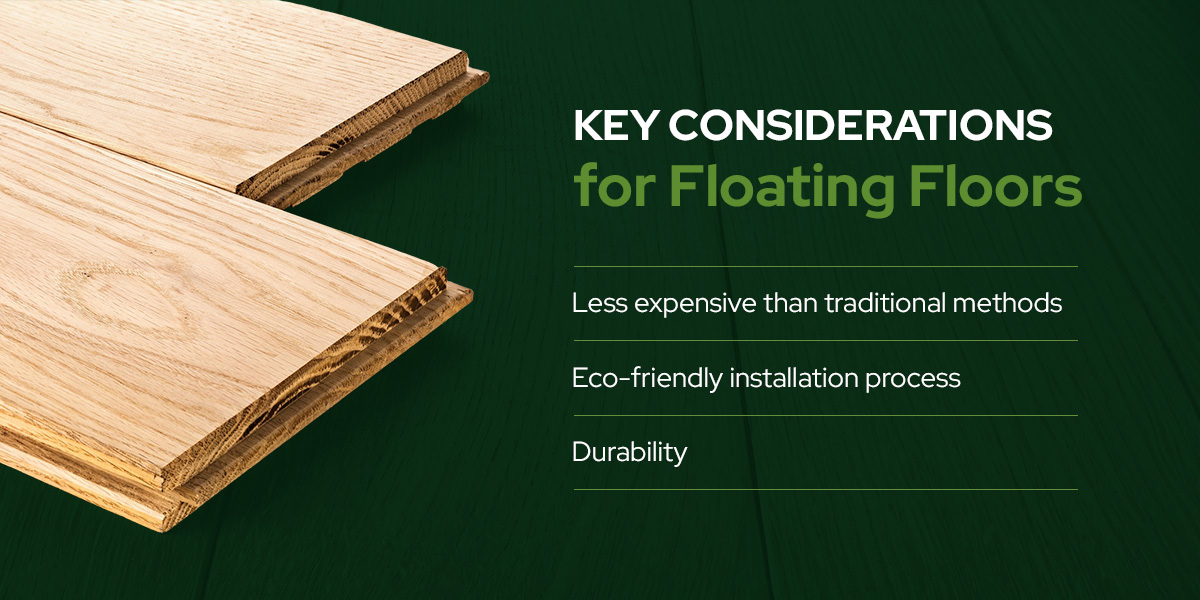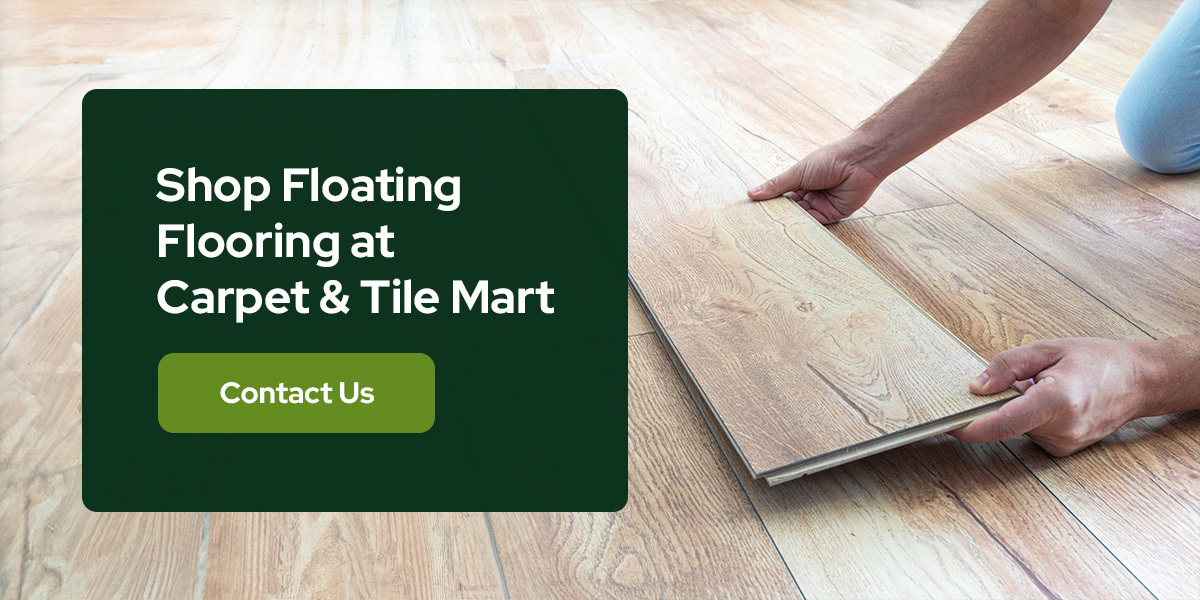Floating Floor Guide
Posted by Ben Garelick (@BlueShirtBenny) on 1st Aug 2025
Floating Floor Guide
The floor is the foundation of every home, and it experiences a lot of wear and tear. When it's time to upgrade your floors or install new ones for a renovation project, floating floors can be a time-saving and durable option.
Below, we dive deeper into installation considerations, materials and benefits in this floating floor guide.
What Is a Floating Floor?
A floating floor does not require nails or glue for installation. Instead, the floor planks interlock together using a click-and-lock method that's similar to a puzzle.
Unlike traditional flooring, the floating floors are placed directly above the substrate or subfloor without attachment, making them easier to install and update.
Types of Floating Floors
There are several floating flooring materials you can pick from:
Laminate
Floating laminate flooring is great for busy homes. It is stylish, durable and resilient.
Laminate flooring mimics the look and feel of natural flooring materials, especially wood, at a fraction of the cost. It is easy to maintain and resistant to stains and fading.
It can work well with the click-and-lock method for floating floors, creating a cost-effective, lightweight floor you can enjoy for years to come.
Engineered Hardwood
Engineered hardwood is made with layers of sustainable hardwood and is finished with real hardwood veneers to match your design needs. It is a cost-saving alternative to solid wood. It is also humidity-tolerant and can provide a beautiful, natural look.
The engineered timber layers are engineered to help manage temperature fluctuations. They do not warp or expand easily, making them ideal for basements, kitchens or humid climates in general.
Luxury Vinyl Planks
Luxury vinyl plank (LVP) offers the look and feel of a natural wood floor. Floating vinyl flooring pieces can click together to create a sturdy, pleasing result that's softer than other materials.
Vinyl is a versatile, attractive option that can last for years with proper installation and care. Furthermore, this option can withstand high foot traffic and will do just fine for residential and commercial floors.
Key Considerations for Floating Floors
Explore some of the leading advantages of floating floors:
- Less expensive than traditional methods: Floating floors are usually cheaper to install. Although professional installation is advised, many homeowners choose the DIY route because they generally do not require any adhesive material or nails to lay down.
- Eco-friendly installation process: Floating floors use less wood, materials, nails and adhesive. You just need your hands and click-lock planks measured to your floor's specifications.
- Durability: The interlocking mechanisms for floating floors can create a strong, sturdy base.
Below are some important considerations for installing a floating floor in your space:
- May need frequent replacement: Floating floors can be more prone to moisture damage, like buckling or warping.
- Cannot be refinished: Floating floors cannot be refinished or sanded like solid wood floors, for example.
- Noise: Since floating flooring is not attached to the subfloor, it may be slightly noisier than other options.

How to Install a Floating Floor
Installing floating floors can be a relatively straightforward DIY project. You can follow these general steps:
- Consult an expert: Consider asking a flooring expert what they suggest for your unique space. They may be able to offer suggestions regarding the right materials and measuring techniques for your new floors.
- Plan the layout: Determine the direction you're going to lay your planks and take precise measurements of your room. Leave a little space to allow the flooring to expand and contract over time. Plan your layout ahead of installation to ensure you have enough planks to adequately cover the floor.
- Prepare your space: Once you choose your flooring type, allow the planks to acclimate to the room's temperature and conditions for about two days. Clean the subfloor and correct any issues prior to laying down your new floating floor.
- Go row by row: Choose a corner of the room to begin installation. Remember to add spacers between the plank and the wall. The easiest way to install floating floors is to connect planks end-to-end, completing the row along the wall before attaching the next planks to the side and working toward the middle of the room.
- Add the finishing touches: Once all of your floating floor planks are installed, it's time to tend to the finishing touches, like adding trim around the perimeter of the room and ensuring all planks are perfectly aligned.
Maintenance and Care for Floating Floors
Proper maintenance is key to maximizing your investment and supporting the longevity of your floating floors:
- Regular cleaning: Vacuum your floors at least once a week to remove any dirt, debris or pet hair. Use only mopping and cleaning solutions that are suitable for your floor's material. A mild soap or white vinegar diluted in water is often best.
- Preventive care: Combat issues with your floors by using furniture pads to prevent the legs of chairs, tables or sofas from scratching the surface. Clean up spills immediately and keep your space at a low humidity level to avoid moisture-related problems.
- Prompt repairs: If you notice any damage on your floating floors, such as gaps, buckling or scratches, prioritizing repairs can help you prevent these issues from becoming more significant and costly problems.
Frequently Asked Questions about Floating Floors
Explore some of the most common questions homeowners ask regarding floating floors.
What Is the Lifespan of a Floating Floor?
The lifespan of your floating floor will depend on several factors, including how well you install it, the materials used, the room's environment, use and ongoing maintenance. To elongate the life of your floors, always invest in quality options from a reputable provider and prioritize proper care.
Can I Put a Floating Wood Floor Over Tile?
You can install a floating wood floor over the existing tile, but the existing tile must be in good condition, level and free of cracks and damage. You can address minor imperfections with leveling compounds or filler.
Can I Put Cabinets on Top of a Floating Floor?
Installing your kitchen cabinets directly on top of a floating floor is not recommended. Floating floors like vinyl or laminate are designed to expand or contract with changes in temperature and humidity. The weight of the cabinets can restrict this movement, potentially leading to damage to the floors.
Shop Floating Floors at Carpet & Tile Mart
Looking to get one of our floating floor systems for your space? At Carpet & Tile Mart, we are passionate about helping you find the perfect option for your home.
We offer various flooring products, including rugs, carpets, laminate, vinyl and hardwood. Our friendly team can help guide you through your next flooring purchase. Find a location near you today!




